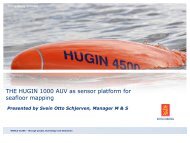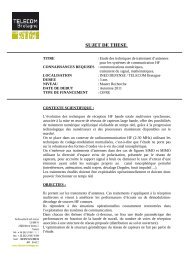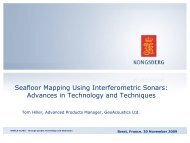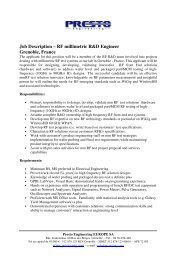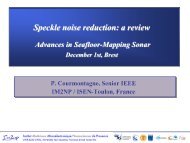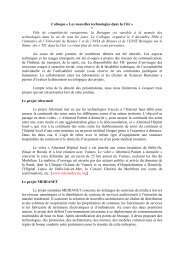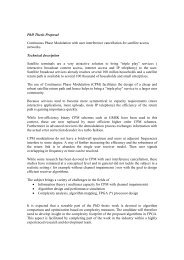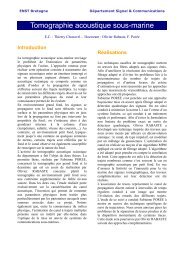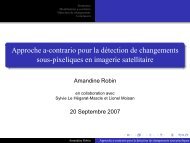Département Réseau, Sécurité et Multimédia Rapport d'Activités 2008
Département Réseau, Sécurité et Multimédia Rapport d'Activités 2008
Département Réseau, Sécurité et Multimédia Rapport d'Activités 2008
Create successful ePaper yourself
Turn your PDF publications into a flip-book with our unique Google optimized e-Paper software.
the different components is consistent and notredundant.ConclusionAs work in progress, we are currently studyinghow to extend our approach in the case wher<strong>et</strong>he security architecture includes IPv6 devices.More specifically, the construction of new VPNtunnels (e.g., IPv6-over-IPv4) for IPv6n<strong>et</strong>works must be revised, and moreinvestigation has to be done in order to extendthe approach aforementioned. In parallel tothis work, we are also extending our approachto make cooperate routing and tunnellingpolicies.and deploy a n<strong>et</strong>work security policy. SecondWorkshop on Formal Aspects in Security andTrust (FAST). Toulouse, France. August 2004.[2] S. Preda, N. Cuppens-Boulahia, F.Cuppens, J. Garcia-Alfaro, L. Toutain. ReliableProcess for Security Policy Deployment.International Conference on Security andCryptography (Secrypt 2007), Barcelona,Spain, July 2007.[3] J. G. Alfaro, F. Cuppens, and N. Cuppens-Boulahia. “Aggregating and Deploying N<strong>et</strong>workAccess Control Policies”. In 2nd InternationalConference on Availability, Reliability andSecurity (ARES 2007), April 2007.References[1] F. Cuppens, N. Cuppens-Boulahia, T. Sansand A. Miège. A formal approach to specifyExpression of security policiesResearch Staff : Frédéric Cuppens, Nora Cuppens-Boulahia, Fabien AutrelKeywords : Security policy, OrBACApplications : Security policy specificationPartners & Funding : partially funded by ANR in the framework ot the SETIN Polux projectIntroductionCurrent information systems have to facemany threats that attempt to exploit theirvulnerabilities. Moreover, since informationsystems tend to be increasingly complex,specifying their security policy is a tedious anderror-prone task. In this context, specifyingconsistent, relevant and compl<strong>et</strong>e securitypolicies of information systems is a majorchallenge for researchers.There are many advantages of using a formalapproach to specify the policy: (1) It providesnon ambiguous specification of securityrequirements, (2) It is possible to developsupport tools to formally analyze theserequirements, (3) It is also possible to developsupport tools to assist the securityadministrator in the task of automaticallydeploying these requirements over a securityarchitecture.A security policy may actually specify verydifferent security requirements. The literaturehas primarily focused on access control andinformation flow control requirements andmore recently on authentication and usagecontrol requirements. Specifying administrationand delegation policies is also a more andmore important issue, especially in the contextof pervasive distributed systems. Finally, thesecurity policy should also specifyrequirements that apply when some intrusionsoccur. They are called reaction requirementsand are also part of the security policy.The ANR SETIN POLUX project (Policy UnifiedExpression) aims to define an environment toexpress access and usage control policies andapply it to a s<strong>et</strong> of components performingprotection, d<strong>et</strong>ection and reactionfunctionalities. The security policy must bespecified using precise and non ambiguousformal languages in order to prove the formalverification and validation of the security policydeployment over h<strong>et</strong>erogeneous systems.Pracom’s Annual Report <strong>2008</strong> 33



